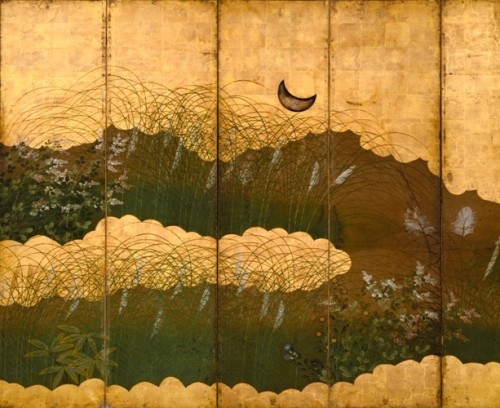From Hara Museum ARC, Gunma

Attributed to Oguri Sotan, Scene of monkey and full moon, Muromachi period
Currently on view at the Kankai Pavilion (in Hara Museum ARC) is an exhibition on a theme of autumn.
When one thinks of autumn colors, the first thing that comes to mind is the moon. Moon-viewing in Japan occurs on August 15 in the old lunar calendar, which is the date of the “mid-autumn” moon, renowned for its beauty since olden times. This exhibition showcases works that take as their motif the moon. In these seasonal images and narratives, the aesthetic sensibilities and connection with nature of the people of those times shine through, perhaps throwing new light on the nature that surrounds us today.

Field with the moon, the subject called “Musashino” in Japanese (detail), Edo period
In waka poetry, Musashino, a desolate plain with nothing to obstruct the view, has long been used as a representation of rustic beauty. Musashino appears often in such anthologies of poetry as the “Man’yo-shu” and “Kokin Wakashu,” as well as “Ise Monogatari” (The Tale of Ise). A waka poem from the “Shoku Kokin Wakashu” describes Musashino as a place “lacking hills for the moon to hide behind, where clouds overlap the ends of Japanese pampas grass.” In this painting, gold foil is used in the gold-colored clouds, and heavily applied silver is used to form the crescent moon. Wildly growing Japanese clover, Chinese bellflower and other autumn flora are placed here and there, and fine, thin leaves are delicately expressed using overlapping curving lines that fully express the feeling of autumn within a wild plain that seems to extend beyond the borders of the picture.
[On view in Part I]
“Scene of monkey and full moon” attributed to Oguri Sotan, hanging scroll, Muromachi period/ Kano Sotoku, “Yang Guifei playing chess,” hanging scroll, Momoyama-Edo period ((part of a set of twelve hanging scrolls by painters of the Kano school)/ Kano Shiro-jiro・Sadanobu, “Wang Zhaojun,” hanging scroll, Edo period ((part of a set of twelve hanging scrolls by painters of the Kano school) /“Field with the moon, the subject called ‘Musashino’ in Japanese,” eight-fold screen, Edo period/ Attributed to Mori Sosen, Monkeys on a tree, hanging scroll, Edo period/ Kumi Sugai, “Moon,” 1957 and others
[On view in Part I and II]
Attributed to Emperor Shomu and others, “Book of model handwriting, called ‘Reiso-dai’,” Nara-Muromashi period/ “Tier of boxes decorated with design of squirrels in vine scrolls in maki-e,” Edo-Meiji period/ Jae-Eun Choi, “Homage to Mozart,” 1988/ Toko Shinoda, “Virtuoso,” 2003/ Noe Aoki, “Tateyama,” 2007/ Hiroe Saeki, “Untitled,” 2009, and others.
HARA MUSEUM ARC exhibitions
Kankai Pavilion (featuring traditional art)
The Colors of Autumn
Part I: September 11 (Sat.) – October 11 (Mon./ National Holiday), 2010
Part II: October 16 (Sat.) – November 14(Sun.), 2010
Contemporary Art Galleries
Cheer up! Art can make you happy—Selections from the Hara Museum Collection
Dates: September 11 (Sat.) – December 5 (Sun.), 2010
< Official website> http://www.haramuseum.or.jp
< Mobile site> http://mobile.haramuseum.or.jp
